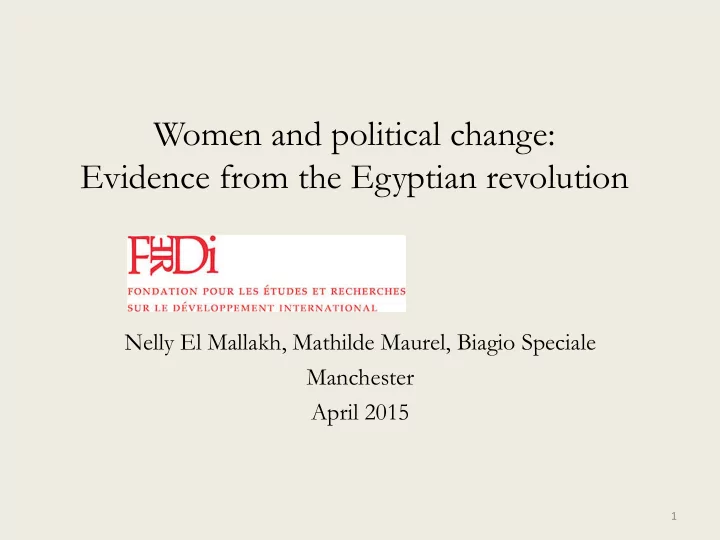

Women and political change: Evidence from the Egyptian revolution Nelly El Mallakh, Mathilde Maurel, Biagio Speciale Manchester April 2015 ¡ 1 ¡
Introduction - Objective - Analyze the effects of the 2011 Egyptian revolution on the relative labor market conditions of women and men - Empirical methodology - Unique measure of the intensity of the revolution (demonstrators who died during the protests) - Panel data: information before and during political unrest 2 ¡
Introduction (2) - Results 1. Reduction of the gender gap in labor force participation 2. Intra-household risk sharing as most likely mechanism 3. Women in households at the bottom of the pre-revolution income distribution 3 ¡
Introduction (3) - Relevance of the results - Several countries are experiencing in recent years a wave of protests, known as the “Arab Spring” - Shed light on how these political changes in the Arab World are shaping the gender gap in the labor market - Egypt is a country with a large segregation by gender (United Nations, 2013; World Economic Forum, 2013) - Empowering women may benefit economic development (Duflo, 2012; United Nations, 2005) 4 ¡
Introduction (4) - Relevance of the results (continued) - Short term relevant temporary shocks to the labor division between women and men can have long term consequences on the role of women in society - Related literature on labor force participation: - Goldin, C. (1991). "The Role of World War II in the Rise of Women’s Employment", American Economic Review, vol. 81(4), pp. 741-756. - Acemoglu, A., Autor, D. H. and D. Lyle (2004). "Women, War, and Wages: The Effect of Female Labor Supply on the Wage Structure at Midcentury", Journal of Political Economy, vol. 112(3), pp. 497-551. - Teso, E. (2014) "The Long-Term Effect of Demographic Shocks on the Evolution of Gender Roles: Evidence from the Trans-Atlantic Slave Trade", mimeo. - Grosjean, P. and R. Khattar (2014). "It’s Raining Men! Hallelujah?", mimeo. 5 ¡
Data 6 ¡
Data on demonstrators who died during the protests (“martyrs”) Governorate ¡ Type ¡of ¡ Cause ¡of ¡ Site ¡of ¡ ClassificaBon ¡ Name ¡ Incident ¡ and ¡date ¡of ¡ incident ¡ death ¡ incident ¡ of ¡incident ¡ the ¡incident ¡ 7 ¡
Stylized facts 8 ¡
Specification and methodology • Difference-in-Differences specification • First-differenced parsimonious specification 9 ¡
Identification strategy - Econometric challenges - Measurement error in the number of “martyrs” variable - Unobserved time-varying labor market shocks at the governorate level - Inverse causality - IV approach - Distance to Cairo City as instrument for the number of “martyrs” - Political participation is spatially or geographically clustered (Mutz, 2002; McClurg, 2003; Cho and Rudolph, 2008) 10 ¡
Evidence on the relevance of the instrumental variable ¡ 11 ¡
Threats to identification (2) - Pre-revolution governorate controls (interacted with the female dummy): 1. share of public sector employment by governorate in 2006 2. number of police stations by governorate per 10,000 inhabitants 3. the average number of years of schooling for individuals aged 15-30 by governorate in 2006 4. natural log of GDP per capita by governorate in 2005/2006 5. dummy variable for fully urban governorates (Cairo, Alexandria, Suez and Port Said) 12 ¡
Results: labor market outcomes 13 ¡
Results: labor market outcomes (2) 14 ¡
Robustness checks - Robustness checks: - Number of injured as alternative measure of revolution intensity - Number of arrested as alternative measure of revolution intensity - Placebo regressions - Eliminating the capital Cairo (where there are most public sector employment opportunities) è larger increase in women’s employment 15 ¡
Results: Robustness Checks 16 ¡
Results: Robustness Checks (2) 17 ¡
Falsification Test: Placebo Regressions 18 ¡
Results: Heterogeneity of the effects • Results: Heterogeneity of the effects – Income – Education – Religion 19 ¡
Results: Heterogeneity of the effects 20 ¡
Results: Heterogeneity of the effects 21 ¡
Results: Labor Market Outcomes by religious groups 22 ¡
Results: mechanisms (1) • The revolution has negatively affected men’s remuneration and increased its volatility • Intra-household risk sharing mechanism ê Increase in women’s labor force participation 23 ¡
Results: mechanisms (2) 24 ¡
Results: mechanisms (3) 25 ¡
Results: mechanisms (4) 26 ¡
Concluding remarks - The Egyptian revolution has reduced the gender gap in labor force participation mainly through: - An increase in women’s private sector employment - An increase in women’s unemployment - Intra-household risk sharing as most likely mechanism: The revolution has negatively affected men’s remuneration and increased its volatility - Short-term effect, but a relevant temporary shock to the labor division between women and men can have long run consequences on the role of women in society 27 ¡
Recommend
More recommend